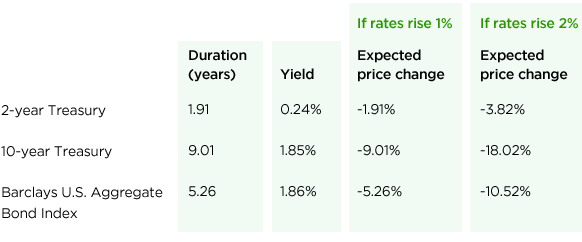Duration risk Income Investing
Post on: 25 Апрель, 2015 No Comment

Beware Heightened Bond Risk In Target Funds
By Michael Aneiro
Liam Plevin and Joe Light take aim at target funds in a story in todays Wall Street Journal. saying such mutual funds are putting savings at risk for many soon-to-be retirees at a time when interest rates will likely soon rise:
The funds typically increase their bondholdings with the approach of the target date, which is pegged to the investors expected retirement year…. But if yields rise and bond prices slump, as many experts predict, the funds could suffer losses.
Most funds targeted to 2015 and 2020 hold between one-third and one-half of their assets in bonds—much more than the 10% to 20% bond positions in some 2040 funds.
The simplest way to gauge the risk of bond losses is by a measure called duration, which tracks a bonds sensitivity to interest rates. The value of a bond portfolio with an average duration of five years, for example, would sustain a loss of 5% if interest rates rose by one percentage point immediately.
The story says that all else being equal, if interest rates were to double, the bond portfolios in many 2015 and 2020 target-date funds could lose as much as 8% to 10%, while even a relatively modest rise in rates could produce losses. In a more extreme scenario approximating the biggest 12-month rise in the 10-year Treasury rate in the past half century, bond holdings in those funds could suffer losses of 12% to 28%.
File this in the growing archive of warnings aimed at bond investors as markets await a long-anticipated rise in interest rates. Much of that has come under the heading of the feared Great Rotation out of bonds and into stocks. So far thats yet to materialize, much like any rise in interest rates. Itll happen eventually, but betting on the timing and magnitude is proving to be guesswork so far.
Oct 24, 2012
10:59 AM ET
Bernanke Has Set A Trap For Bond Investors When Rates Rise
By Michael Aneiro
This blog has spent much time looking at what could happen to bond investors when interest rates inevitably start to rise, most recently yesterday exploring a possible end-of-cycle great rotation out of bonds and into stocks when rising rates will put a halt to the 30-year bond bull market.
The Financial Times looks at the issue today in a story called Bernankes day of reckoning looms for bond investors . As markets await the end of the Feds latest two-day meeting today, the FTs Stephen Foley, Vivianne Rodrigues and Michael Mackenzie say the Fed chairman may have set a trap for bond investors by promising to hold rates low for now while knowing that one day the Fed will stop making that promise:
That is when millions of investors who have put their money into bonds will have to watch their ankles that is when the steel trap springs shut. Amid record inflows into many bond funds and frenzied buying of corporate debt, fund managers and investment strategists are warning that savers could be losing sight of the risk they can lose money when interest rates begin to rise.
People have completely capitulated, says Michael Collins, senior investment officer at Prudential Fixed Income. You would think that, by now, money would be moving out of bonds into equities. But its not.
Current corporate bond issues offer record-low interest rates, and the retail value of these and other bonds could fall sharply when rates rise and newer bonds are issued with higher coupons. This is boosting duration, or interest-rate risk, across bond portfolios. More from the FT:
This basic bond maths could mean especially large hits to portfolios that contain the longest-term debt.
Mark Kiesel, portfolio manager at Pimco says: “If you think central banks will be successful in reflating, you do not want to own long maturity fixed-rate bonds.
“We are in a very unique time with central banks suppressing volatility and interest rates. You want to take less duration and have less interest rate risk and look for growth opportunities that will outperform over time.”
- Previously in duration risk Next in duration risk














